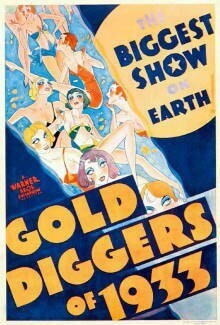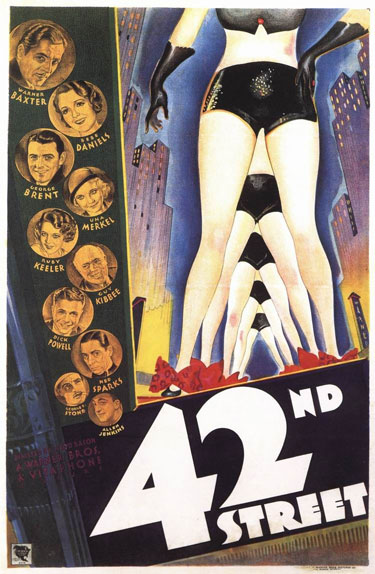There’s a sense of magic in the air when walking down the streets and alleyways of Warner Bros Studios. For it was there that great stars such as Bette Davis, James Cagney, Humphrey Bogart and yes, little dancing star Ruby Keeler, made their way to the sound stages where their films became classics of the Golden Era.
Ms. Keeler was a petite and innocent-faced young girl when she developed an interest in dancing. Born into an Irish-Catholic family in Nova Scotia, Canada on August 25, 1910 as Ethel Hilda Keeler, she and her five siblings, mother, and father, moved to New York City where job prospects were better. Little Ruby was only three years old, but she loved to dance. Unfortunately, her family was too poor to enroll her in a dance studio for lessons. However, a sympathetic dance instructor at her parochial school decided to help out the talented girl by allowing her into class.
At this time, Ruby was only 13 years old, but she and some of her girlfriends decided to lie about their age and attend an audition for a show. She tapped her little heart out and was rewarded with a part in the chorus of producer George M. Cohan’s musical The Rise of Rosie O’Reilly. A year later, at age 14, producer Nils Granlund saw her and hired her to appear in the famous show at Texas Guinan’s gangland nightclub. Luck usually comes when you are seen by the right people, and one of the “right” people was Broadway producer Charles Dillingham who immediately cast her in Bye, Bye, Bonnie in 1926. During the six-month run, another Broadway legend, producer Flo Ziegfeld, saw the future “Ruby Keeler” and cast her in the Eddie Cantor show Whoopee! in 1928.
Before beginning rehearsals for Whoopee!, Granlund sent Ruby off to Los Angeles to participate in a promotion for the Al Jolson film The Jazz Singer. Although Ruby was then only 17, she met and fell in love with Jolson, then age 42. Considered the “world’s greatest entertainer,” Jolson has the historic distinction of starring in the world’s first all-talking picture made at Warner Bros. The two lovebirds got married, and Ruby’s part in Whoopee! was given to actress Ethel Shutta. After their honeymoon, it is reported Ruby toured with the Whoopee! company. Jolson also agreed to her returning to Broadway in 1929 for the Ziegfeld musical Show Girl. During their marriage, the couple adopted a little boy, Al, Jr.
Because of Jolson’s status in show business, they became “Hollywood Royalty” and Ruby lived lavishly in the Jolson mansion. They knew everybody who was anybody in Tinseltown, so Ruby was exposed to all the greats of the time. She quickly caught the attention of young producer Darryl Zanuck, who cast Ruby in the iconic musical 42nd Street at Warner Bros., co-starring with crooner Dick Powell. Zanuck was making a name for himself at Warner Bros by producing the Rin Tin Tin dog movies. After leaving Warners, he combined his 20th Century Pictures with William Fox’s studio and founded 20th Century Fox Studios in Century City. However, his big discovery in 1933 was Miss Keeler, and the musical was to go on to be one of the most significant films of the 1930s and for all time.
42nd Street
Warner Bros and studio mogul Jack Warner spared no expense on this picture. The Depression was in full swing, and downtrodden people in America wanted to be entertained and be happy when they went to see a movie. 42nd Street was to be their be-all and end-all in entertainment. Sprinkled with fresh-faced newcomers (Keeler and Dick Powell) and with, up-and-coming future stars such as Ginger Rogers and George Brent, and old favorites such as Una Merkel, Ned Sparks, George E. Stone, and Bebe Daniels, and with the appearance of blond bombshell Toby Wing for eye candy, the picture couldn’t miss.
The cast was terrific, of course, but what really set the film apart was the music by Harry Warren and Al Dubin and the tremendously inventive choreography by Busby Berkeley. Standards such as “Shuffle Off To Buffalo,” “You’re Getting To Be A Habit With Me,” “It Must Be June,” and the unforgettable theme song “Forty-Second Street” are sung to this day.
Busby Berkeley was an inventive genius and the “designs” he put on the screen had never been seen in any other film. He devised the over-head camera technique in which he photographed chorus girls in various patterns that looked like scenes in a kaleidoscope. Berkeley would raise the camera boom high into the rafters of the sound stage and shoot directly downward. Had the film been in color it would have been even more dazzling (see 20th Century Fox’s The Gang’s All Here! with Alice Faye and Carmen Miranda for a sample).
Born into a show business family, Berkeley became a child actor on stage. He later choreographed many Broadway musicals and was innovative at that time as well. When producer Samuel Goldwyn hired him for Eddie Cantor musical films, Berkeley originally devised his geometric dance patterns at Goldwyn Studios.
Lloyd Bacon directed 42nd Street in 1933. It has since been considered a “classic” musical and has been honored with an Academy Award© nomination as Best Picture of 1934 and was selected for preservation in the United States National Film Registry. It set the pattern for backstage musicals for years to come.

Jack Warner was so impressed by the 23 year-old newcomer that he signed Ruby Keeler to a long-term contract. She followed 42nd Street with Golddiggers of 1933, Footlight Parade, Dames, Flirtation Walk, Go Into Your Dance, and Ready, Willing and Able.
By 1937 Jolson thought he could better manage Keeler’s film career and essentially ruined it. He got her to leave her lucrative Warner’s position and signed her to a contract at thread-bare RKO Studios for the film Mother Carey’s Chickens in 1938. The movie was a gigantic flop and put Keeler’s film career into a tailspin. Husband and wife starred together for the last time in a Broadway fiasco called Hold Onto Your Hats in 1940. They divorced that same year.
In 1941, Ruby met and married real estate mogul John Homer Lowe and essentially retired from show business to raise a family. The couple produced four children.
She returned from obscurity in 1963 when she appeared in a television show and again in 1970 in a small part in the film The Phynx.
By 1972 she was almost totally forgotten when she was offered the stage revival of No, No Nanette at age 62. Originally produced in the 1920s, Ruby was a logical choice to revive that era on stage once again. By coincidence, Busby Berkeley – her old choreographer at Warner Bros. – was also hired to supervise the musical numbers. Co-starring with Keeler were stage veterans Jack Gilford and Helen Gallagher plus MGM dancing star Bobby Van and classic comic Patsy Kelly, the show as a smash and Keeler played it for two years in New York. She did another two-year stint on the road with the show.
She retired into seclusion once again and lived for another 20 years in Palm Springs. Taken ill at 83, she died from cancer February 28, 1993 in Rancho Mirage.







